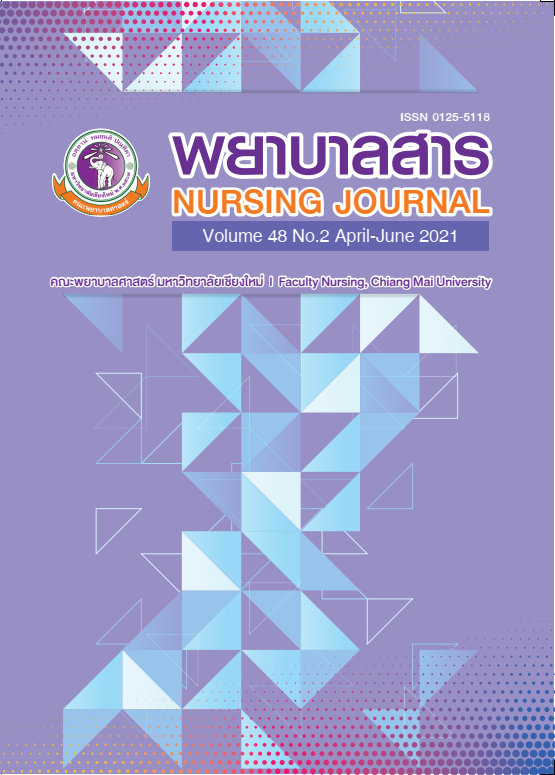Effect of Self-Regulation Enhancement on Aseptic Technique Practices of Wound Management Among Registered Nurses in Accident and Emergency Department
Keywords:
Aseptic technique, Wound management, Self-regulation, Emergency department, Infection PreventionAbstract
Wound infection is a problem in hospital, accident and emergency departments, with high incidence attributed to improper aseptic technique during the wound management process. This quasi-experimental pre-post with control group design was used to test the effectiveness of self-regulation on aseptic technique practices of wound management among registered nurses in the accident and emergency departments of two hospitals from November 2015 to January 2016. Aseptic techniques were environmental controls, hand hygiene, appropriate use of protective personal equipment, aseptic field management, and non-touch aseptic technique. A random sampling method was used to select participants into the experimental or control group. At least eighteen events of wound management and stitching activities were observed. The experimental group attended a self-regulation training on the practice of aseptic technique in wound management. The educational training on the self-regulation was provided together with guidelines (Bandura, 1991) Data were collected using general information questionnaires and an observation checklist related to aseptic technique in wound management activities. All instruments were tested for content validity by five experts. The content validity Index was 0.94. Data analysis was performed using the frequency distribution, percentage, average, standard deviation and Chi-squared test.
The results of the study revealed that, after the intervention, proper aseptic techniques in the experimental group increased from 62.53% before the intervention to 89.36% (p<.05) after the intervention. When analyzed by sub-categories, the results revealed that hand hygiene was the technique that was most significantly improved after the intervention; rising from 25.37% before the intervention to 84.50% (p<.05) after the intervention. The appropriate use of protective personal equipment increased from 81.11% to 100% (p<.05). However, the changes in aseptic non-touch technique was non-significant with an increase from 96.67% to 100%. With regards to aseptic field management category, the percentage increased non-significantly from 98.33% to 100% after the intervention. For environmental controls, the results increased from 47.50% to 63.16% after the intervention, though this change was not significant. In all areas, the control group had a low level of practice in each area and this remained unchanged after the intervention. The difference between the rates between the intervention group at the post intervention period were significant.
In conclusion, self-regulation was effective in improving the aseptic techniques and wound management practices of registered nurses in the accident and emergency department in the sub-categories of hand hygiene and the use of protective personal equipment. However, the intervention was not effective in improving the environmental controls thus other strategies should be implemented.
References
Bandura, A. (1991). Social cognitive theory of self-regulation. Organizational Behavior and Human Decision Process, 50(2), 248-287.
Bandura, A. (1997). Social learning theory. Englewood Cliffs, New Jersey: Prentice-Hall.
Bukhari, S. Z., Hussain, W. M., Banjar, A., Almaimani, W. H., Karima, T. M., & Fatani, M. I. (2011). Hand hygiene compliance rate among healthcare professionals. Saudi Medical Journal, 32(5), 515-519.
Ekjit, A. (2012). Effect of self-regulation and education on practices of tuberculosis prevention among patients. (Master of Nursing Science). Graduate School, Chiang Mai university.
(In Thai).
Junkeaw, D. Picheansathean, W., & Yimyam, S. (2013). Effect of creative solving on the use of glove among health care workers. Nursing Journal, 40(5), 1-13.
Marra, A. R., Noritomi, D. T., Westheimer Cavalcante, A. J., Sampaio Camargo, T. Z., Bortoleto, R. P., Durao Junior, M. S., & Edmond, M. B. (2013). A multicenter study using positive deviance for improving hand hygiene compliance. American Journal of Infection Control, 41(11), 984-988. doi: 10.1016/j.ajic.2013.05.013
National Hospital Ambulatory Medical Care Survey. (2010). Emergency Department Summary Tables. Retrieved from http://www.cdc.gov/nchs/fastats/emergency-department.htm
Nawar, E. W., Niska, R. W., & Xu, J. (2007). National hospital ambulatory medical care survey: 2005 emergency department summary. Emergency, 110(4,000).
Quinn, J. V., Polevoi, S. K., & Kohn, M. A. (2014). Traumatic lacerations: what are the risks for infection and has the ‘golden period’of laceration care disappeared? Emerging Medical Journal, 31(2), 96-100. doi: 10.1136/emermed-2012-202143
Spence, R., & Rutherford, W. (1984). Wound infection following surgery in an accident and emergency theatre. Archives of Emergency Medicine, 1(1), 23-27.
Williams, F., & Waterman, H. (1996). An examination of nurses’ practices when performing aseptic technique for wound dressings. Journal of Advanced Nursing, 23(1), 48-54.
Downloads
Published
How to Cite
Issue
Section
License
บทความที่ได้รับการตีพิมพ์เป็นลิขสิทธิ์ของวารสารพยาบาลสาร
ข้อความที่ปรากฏในบทความแต่ละเรื่องในวารสารวิชาการเล่มนี้เป็นความคิดเห็นส่วนตัวของผู้เขียนแต่ละท่านไม่เกี่ยวข้องกับมหาวิทยาลัยเชียงใหม่ และคณาจารย์ท่านอื่นๆในมหาวิทยาลัยฯ แต่อย่างใด ความรับผิดชอบองค์ประกอบทั้งหมดของบทความแต่ละเรื่องเป็นของผู้เขียนแต่ละท่าน หากมีความผิดพลาดใด ๆ ผู้เขียนแต่ละท่านจะรับผิดชอบบทความของตนเองแต่ผู้เดียว






